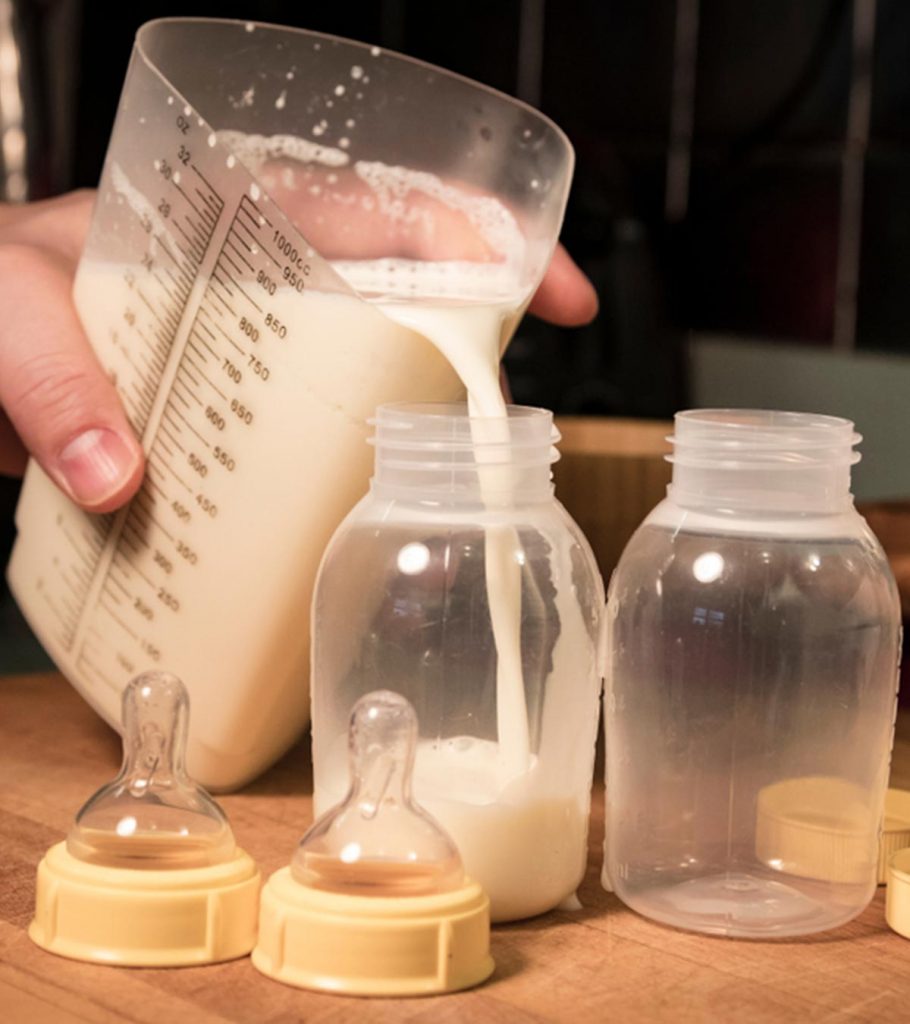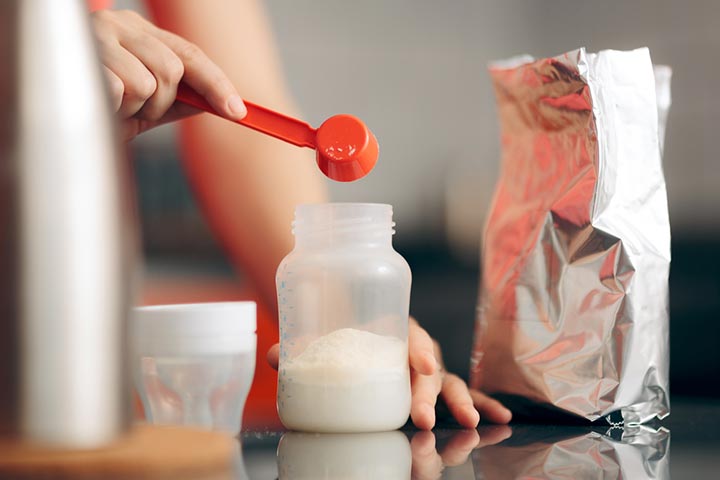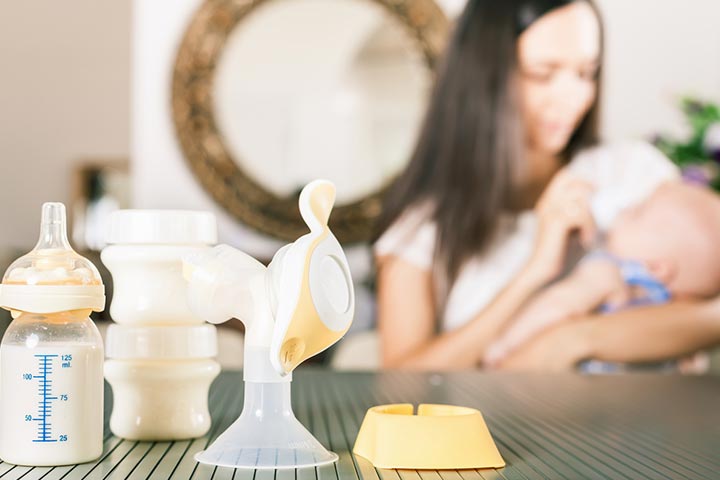Many parents doubt whether it is safe to mix breast milk and formula to feed a baby. Without a doubt, breast milk is the best food for babies up to six months and older. You may feed expressed breast milk if the baby cannot feed directly from the breast.
Sometimes, doctors recommend supplementing infant formula with breast milk to meet your baby’s energy needs. Hence, there is no harm in mixed feeding if you do it as recommended.
Read on to know the correct ways to combine breast milk and formula, its pros and cons, and alternatives to it.
Can You Mix Formula And Breast Milk In The Same Bottle?
Yes, you can mix formula with breast milk. However, experts advise keeping breastfeeding and formula feeding separate since (1):
- The storage guidelines for both formula and breast milk are different. Thus, if a baby doesn’t finish the feed, the breast milk gets wasted as you can’t reuse formula.
- Mixing formula and breast milk may affect some of the protective elements of human milk. It may also affect the total protein and mineral intake of the baby.
Despite the different properties of breast milk and formula, they could be different reasons for mixing formula with breast milk.
Why Mix Formula With Breast Milk?
You may consider mixing formula with breast milk (2) if the baby doesn’t like breast milk’s taste and refuses to feed.
- The baby doesn’t like breast milk’s taste and refuses to feed. Mixing some breast milk with formula could be a choice in such cases.
- The breast milk supply isn’t sufficient for some reason.
- You are returning to work, and the expressed milk is less, you may consider mixing breast milk with formula.
Whatever the reason, consulting a doctor or lactation consultant is necessary before feeding a formula and breast milk blend to your baby.
How To Mix Breast Milk With Formula?
Before you begin, remember that one should never mix formula powder directly to breast milk since it could cause nutrient imbalance. Observe the following steps to mix formula with breast milk correctly.
- Prepare liquid formula or powdered infant formula as per the instructions on the package or as directed by the baby’s doctor. You can mix breast milk directly to a ready-to-feed formula as it is already diluted appropriately.
- The Centers for Disease Control and Prevention (CDC) recommends using water from a safe water source to prepare formula. Since formula is not sterile, the water needs to be at boiling temperature, and then cooled down after mixing with formula powder. Depending on your area’s water quality, you may use boiled tap water or bottled water to make infant formula (3).
- Once the formula is ready, you can add formula to breast milk in the ratio suggested by your doctor and feed the mix to the baby immediately. You can also store the mixed milk in the refrigerator but for no more than 24 hours (4). It is best not to mix it in one bottle and is recommended to first feed the baby breast milk and then formula.
Consulting a doctor is essential to know the right ratio of mixing breast milk and formula for your baby.
Are There Any Benefits Of Mixing Formula With Breast Milk?
Although mixing formula and breast milk isn’t always preferred, it could offer benefits in some cases.
- Could help the baby adjust to the formula’s taste. Experts recommend adding a small amount of breast milk to formula while mothers begin weaning their baby to formula. Once the baby adjusts to formula taste, you can stop mixing formula with breast milk.
- May promote sleep for longer durations. It is because the formula takes longer to digest when compared to breast milk. It may be beneficial in some cases. However, this technique should not be used regularly to make babies sleep for longer. If you are looking for ways to promote long healthy sleep in babies, consult a pediatrician.
Besides these, some mothers and caregivers may find that the mixing of breast milk and formula in one bottle is convenient if the baby is both breast- and formula-fed.
What Are The Potential Risks Of Mixing Formula And Breast Milk?
Below are some of the potential risks of mixing formula and breast milk.
- Wastage of breast milk might happen in cases where the baby tends not to finish the contents of their bottle. In such scenarios, it is advisable to prepare small batches of formula and breast milk mix to prevent wastage.
- Reduction in breast milk supply happens when the frequency of breastfeeding or breast milk expression decreases (5). Mixing breast milk with formula also reduces the time an infant spends suckling, leading to a reduction in breast milk supply. Nursing regularly and supplementing with formula gradually is a good way to maintain an adequate supply of breast milk.
- Possible health risks can occur when breast milk is mixed with formula in inappropriate proportions. For instance, less water can stress the baby’s kidney and digestive system and make them dehydrated (3). Similarly, too much water can make the feed runny and considerably insufficient in essential nutrients. In both scenarios, the baby’s growth, nutrition intake and development are affected.
It is ideal to prefer mixing breast milk with formula only when directed by a pediatrician. You may also consider an alternative.
What Is The Alternative To Mixing Formula And Breast Milk?
Experts recommend mixed feeding or combination feeding for effective supplementation of breast milk in cases where breast milk alone isn’t sufficient. Mixed feeding, also known as partial breastfeeding, is a feeding technique wherein you sometimes feed breast milk and sometimes feed formula, separately, to the baby (6) (7).
This technique could let you and your baby reap the benefits of breast milk and formula separately without worrying about any adverse effects. Nevertheless, mixed feeding should never replace exclusive breastfeeding unless advised otherwise by a doctor. You should try mixed feeding after consultation with a lactation expert or your healthcare provider.
Supplementation of breast milk may be needed at some instances, and mixing formula and breast milk may be the only solution. It is best to do it with expert guidance. A doctor or lactation consultant can guide you on the right way to mix formula and breast milk. Also, they may suggest alternatives better suited to you and your baby.
You may mix breastmilk and formula to gradually wean your baby off breast milk and make them familiar with the taste of formula. Moreover, in situations where your baby rejects breastfeeding or you are unable to breastfeed, mixing formula and breast milk may be the only solution. It is a safe option if you do it the right way and prepare the formulation in small amounts to avoid wastage. Remember to consult your doctor before resorting to mixing breastmilk and formula to know the right proportions. Further, follow the necessary measures to ensure your and your baby’s safety.
Key Pointers
- When breastmilk is insufficient, or the infant begins to reject it, mixing formula may be an alternative.
- It can be a good start to the baby’s weaning process and may also reduce breast milk supply.
- To avoid wastage and protect the baby from any potential health risks, make small amounts and consult a doctor for the right formulation.















